2008 Nissan Cube – Click above for high-res image gallery
You know that you have a disorder when you're as enthused about an econobox as you are to get seat time in something like a Rolls or Bentley. But that's me, and that's how I felt when I got the call at my desk telling me that my new media ride was downstairs waiting for me. I quietly walked out to the stairwell and then, when the door shut behind me, I bounded down them two at a time, like a kid running downstairs on Christmas day. I stepped out into the sunlight, and there it was in all its delightfully quirky, 100% JDM glory: a 2008 Nissan Cube. And for the next four days, it was mine.
All photos Copyright ©2008 Alex Núñez / Weblogs, Inc.
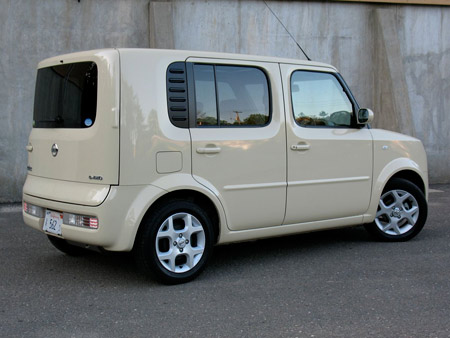
The Nissan Cube has that intangible 'thing" going for it that we last saw when Toyota put Scion branding on its boxy, home-market bB and shipped it across the Pacific as the original xB. The Cube is incontrovertible rolling evidence that basic transportation can indeed be interesting, fun and stylish. There's a timeless retro industrial design feel to some of the car's surfaces, particularly in the softened edges at the corners of the roof and hood. Think of a vintage-style toaster or refrigerator and you'll get my drift. That's not to say that the Cube is a retromobile. On balance, its design is clean and modern.
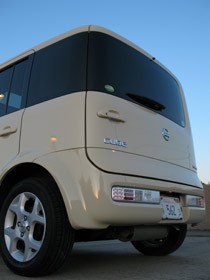
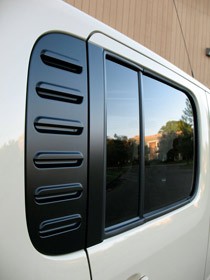
The Cube's signature, more than its boxy shape, is its bodywork's asymmetrical layout, which really gives the car car a lot of visual character. On the passenger side (that would be the left side, since this is a right-hand-drive vehicle), there's a window aft of the rear door that provides added visibility when the driver looks over his shoulder. On the driver's side, there is no corresponding window. Instead, a black trim piece after the rear door helps reduce the visual size of the substantial d-pillar. The apparent rationale behind this design choice is that the driver wouldn't be able see out of a window in that location anyway. Nissan then accentuates the asymmetry by tinting the glass and the rear window, then adding blackout trim that creates a wraparound effect from the passenger side to the rear of the car. The A-pillars are also blacked out, giving a similar visual feel to the front windows, as well.
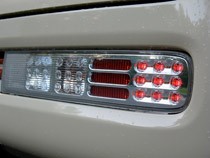
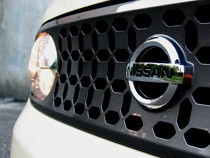
The car's taillamps and brake lights are arranged in rectangular clusters integrated into the rear bunper. They actually drew a number of compliments to the effect of, "Those rear lights look really cool." Agreed. The front end of the car is a simple, clean design in which the grillework creates a pattern of -- what else -- squares. Round foglamps live in the front bumper, and fifteen-inch alloy wheels are pushed all the way out to the corners. This placement minimizes overhangs and maximizes usable interior space.
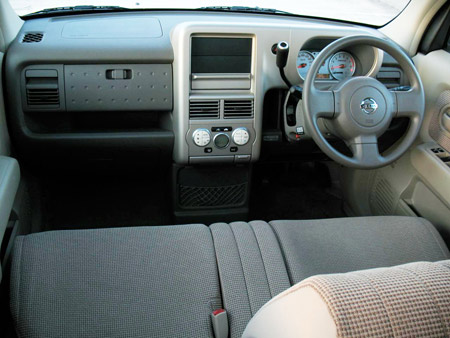
Like other Nissans, the Cube uses a smart key that you never need to take out of your pocket. Pull open the front door and slide into the front seat. If you're me, this is where you curse under your breath because you just got into the passenger side like a complete jackass. No worries. Lift the center armrest and just slide on over to the driver's perch. You can do this because the Cube has a flat floor and a bench seat in front. It's upholstered in tan cloth with flecks of red and blue mixed in, and despite its plain appearance, is actually quite comfy. The IP is finished in complimentary hues and plastic textures, and the material and build quality seemed to be high. If you're looking for any soft-touch surfaces on the instrument panel, you're put of luck.
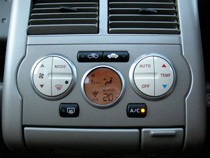
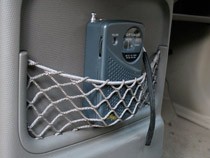
Behind the simple 3-spoke steering wheel is an instrument cluster containing the bare essentials: speedo, tach, and fuel gauge. The column shifter and wiper controls jut out to the left of the column, while the turn signals and light controls are on a stalk to the right. I probably activated those windshield wipers instead of the turn signal around twice a day. Also to the right of the steering wheel, mounted somewhat out of the way, are switches for the e-4WD system, the headlamp angle adjuster, and power mirror controller. The center stack is topped by the audio system, or more accurately in the case of our tester, the dead space where the audio system would normally reside. Straightforward HVAC controls were mounted a little further down, with the ashtray and power outlet situated immediately below them. A netted area sat just above the floor, and that's where I stuck a small transistor radio. Hey, whatever works, right?
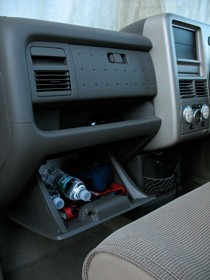
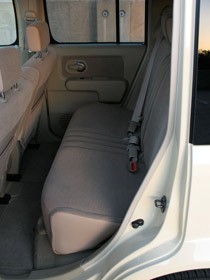
The front seat occupants have a total of four cupholders, and other storage areas include a small shelf on the passenger side, plus over/under gloveboxes. The top one is small, but the lower one easily swallowed a hardcover novel, two half-liter bottles of water, the owner's manual, and the case for my point-and-shoot camera. The center armrest (when in use) also contains a covered storage bin. The back seat is pretty much just like the front - a bench with a flip-down center armrest. Instead of a storage cubby, however, the rear armrest has a pair of molded-in cupholders. The back seat is mounted on tracks that allow it to be be moved fore and aft. The lever to do so is accessible only from the rear cargo area, though. We left the rear bench pushed all the way back to maximize rear legroom.
The Cube handled lunch hour with three friends without generating any major complaints from anyone. The only casualty was my 6-foot 4-inch buddy Jim's right knee, which took two solid blows from the bottom corner of the center stack as he got into the front passenger seat. Once settled, however, he was comfortable and held no grudge -- he wound up being a big fan of the car in general. Two additional colleagues of average size rode in back, and they were comfortable, as well.
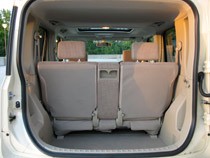
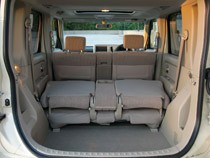
The cargo area has a slightly recessed, flat load floor. You access it by swinging open the large rear cargo door, which is hinged on the right side. If you need more room, you can slide the rear bench forward and flip down the seatbacks to create an additional shelf. Nissan thoughtfully includes a coat hangar in a recessed cubby on the right, as well as some bag hooks on the opposite wall. In Japan, there's also an extended-wheelbase version called the Cube3 (or Cube Cubic) that adds a 3rd row of seating. Now that you know where everything is, let's go for a drive.
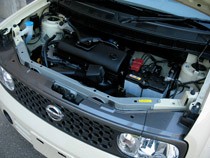
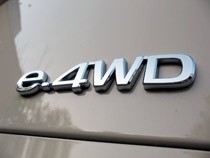
Twist the ignition switch and the Cube's 1.4L four-cylinder immediately buzzes to life. It's rated at 95 horsepower at 5,600rpm and 100 lb-ft of torque at 3200 rpm. This particular engine is paired with a 4-speed automatic (1.5L Cubes get a CVT), and our tester also had the e-4WD system. Instead of saddling the cube with the added weight and complexity of a traditional AWD setup, e-4WD uses an electric motor on the rear axle to drive those wheels when conditions call for added traction. Activating the system is simply a matter of pushing a dash-mounted button and the setup lets the Cube retain its flat cabin floor while still offering the security blanket of all-wheel-drive functionality. I had mostly dry weather, and unfortunately never had a need to bring e-4WD into the picture.
The four-speed auto has a 4.072 final drive ratio, which really makes it well-suited to local duty. As a grocery-getter, the Cube's a champ, with good low-end pickup and enough spunk to handle the rigors of suburbia. The price you pay for this low-speed adeptness becomes apparent when you take the Cube on the highway. Assuming that your route isn't clogged with traffic, you need to stand on the accelerator to get the Cube up to merging velocity. And get there it does... eventually. Once you're up to speed, maintaining it isn't a problem. I had no trouble cruising along between 60 and 75 mph, an act you can make more exciting by pretending that the '120' on the speedometer represents mph instead of kilometers per hour. On the downside, you're consistently running the engine between 3,000 and 4,000 rpm, so fuel economy is going out the window. Despite the car's relatively light weight (2,535 lbs) and little motor, we averaged just 22 mpg in mixed use.
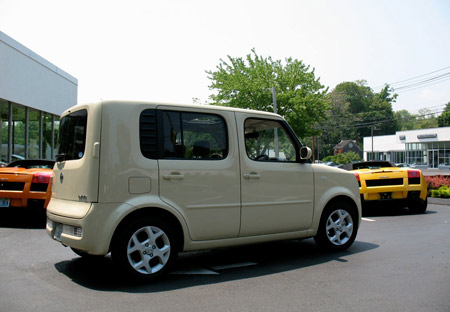
The Cube's ride is pretty compliant, and at around-town speeds, it's a pleasure. Speed bumps and potholes are absorbed without drama. Again, there's a tradeoff for the comfortable ride. Give the Cube a little kick in the pants, try hustling it through some corners, and you'll acquaint yourself with some serious body roll. Go-kart-like handling is obviously not on the Cube's list of attributes. Exercise moderation at the wheel, and you'll be just fine.
So, what can we expect when the 3rd-generation Cube arrives here next year? More power is pretty much a lock. The JDM-spec engine is fine in town, but works too hard on the highway where many Americans spend a lot of time commuting. We'd also expect to see gearing that's more reflective of our market's needs, and that should help push the Cube's fuel economy higher. While we've seen one leaked photo of something purported to be the next Cube -- a more rounded take on the current vehicle -- we've also seen spy shots that show something similar in shape and proportion to the Denki Cube concept displayed at New York Auto Show. This gives hope to those, like myself, who would prefer something styled more in tune with the current car. The biggest question mark surrounds how exactly Nissan plans to handle the car's trademark asymmetric styling. Simply moving the steering wheel over would present drivers with a massive blind spot on the passenger side. Kudos to Nissan if it produces a LHD market-specific body that puts the extra window on the right side of the car, retaining both the asymmetry and the benefit it is supposed to give the driver. We'll have to wait and see what happens, and keep our fingers crossed. The U.S.-spec Nissan Cube will be unveiled at the 2008 Los Angeles Auto Show.
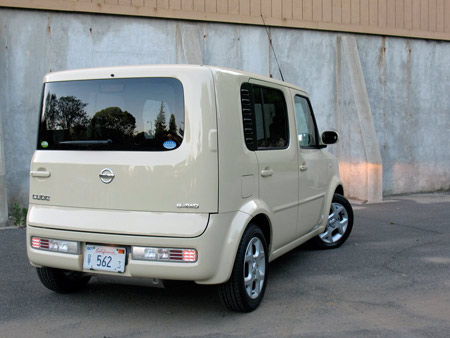
One of the benefits of driving a right-hand-drive vehicle, besides the ability to easily snoop in people's mailboxes (I kid, I kid... don't call the FBI), is that it's easy to answer other drivers' questions while waiting for a light to turn green. After "What is it?", the next most popular questions were, "Can I buy one?" and "How much?" If Nissan can deliver a U.S.-market Nissan Cube that's as nifty as the JDM car while keeping the price of entry in the teens, it's going to have a hit on its hands and the Scion xB will have good reason to look over its shoulder.
Click here for translated Nissan Cube tech specs at Nissan Cube Life.
All photos Copyright ©2008 Alex Núñez / Weblogs, Inc.
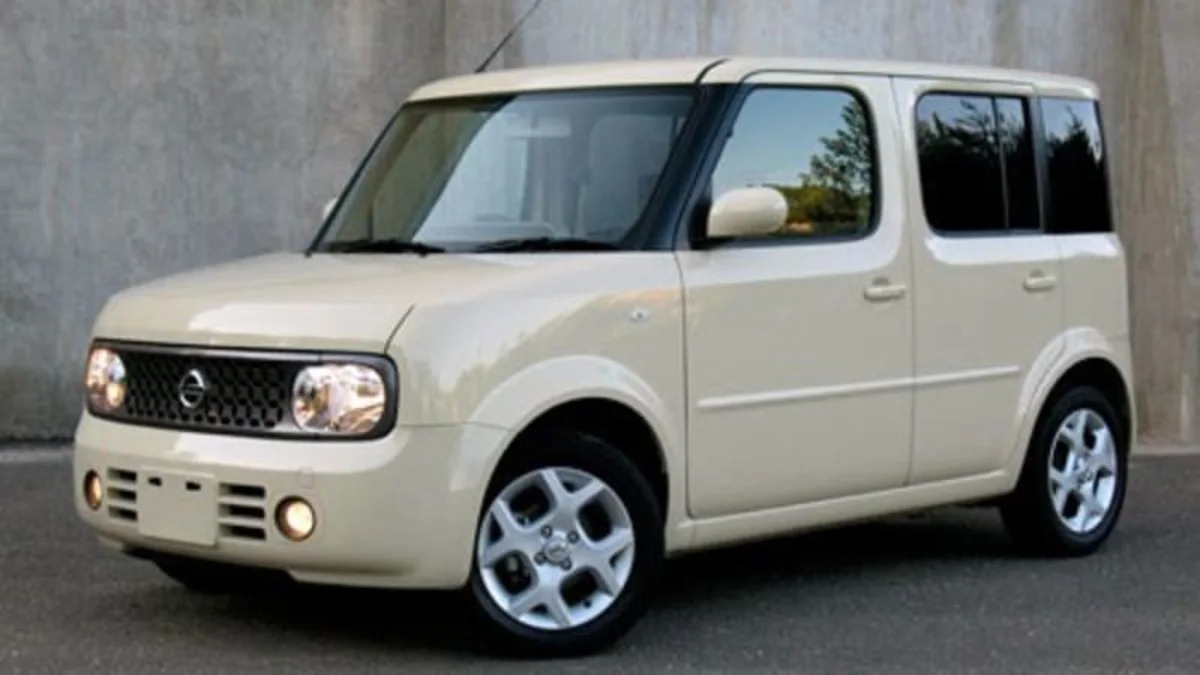


Sign in to post
Please sign in to leave a comment.
Continue